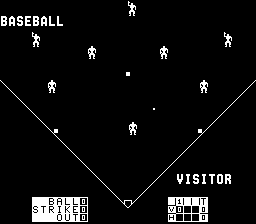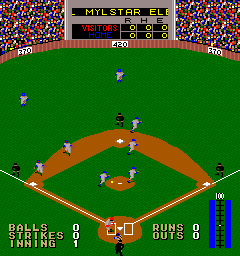MAME Baseball History

Flyball
1976, Atari

This is the one that started it all. Flyball was released by Atari in 1976. It runs on a 6502, and is black and white. Classic. Two players at once are supported, and the only people show in-game are the pitcher, batter, and any characters on-base. There is no outfield in '76.
Summary: This is actually pretty fun. Input was messed up, but even so, we were able to have a good time playing Flyball.
Tornado Baseball
1976 Midway

Presumably released as a reaction to Atari's Flyball, this game is terrible. The ball moves like a relativistic particle, and all the players appear to be armed with bats. While an interesting interpretation of baseball, it's not very fun.
The batting player only gets one swing per pitch, and there's no direct input - just hit the button at the right time. All the players in the outfield move as a group, much like fooseball. Half the guys move smoothly, and the other half move fast in huge jumps. The first hundred balls we played were all outs or fouls. The second hundred were mostly home runs, doubles, and triples.
Summary: Not worth it.
Double Play
1977 Midway

Identical to Tornado Baseball, with the addition of scoreboard and "May the better player win" in the new instructions.
Summary: Even less worth it.
Extra Inning
1978 Midway

Summary: Third try for Midway on this game, and it still sucks.
Atari Baseball
1979 Atari

This game is fantastic, because it features an infinitely steerable ball. Comedy gold. You can actually throw the ball, have it orbit you, and catch it with the same player you threw it with. The outfielders can also be moved wherever you want - including having all of them on top of the pitcher.
The main downside is an interminable delay between selecting a pitch and when the game decide to actually let play proceed.
Summary: A good time, although not exactly true to the real world.
Extra Bases
1980 Midway

When you see this, you'll say the same thing we did: "The same goddamn game, in color." They add a little bit of perspective but it's otherwise identical to the first four incarnations.
Summary: Run screaming.
Curve Ball
1984 Mylstar

The first nondescript game we've run into thus far. It has color, sound, and you have to charge up your pitches, which is kind of a neat idea.
Summary: Not bad, not great. You could do worse than playing this. A lot worse.
Baseball
1984 Nintendo

Nintendo enters the fray with the "Play Choice Ten" and their baseball game, imaginatively titled "Baseball." This is pretty good, although they do take some liberties with rules of both the fine old game of baseball, and the rules that define the motion of bodies, otherwise known as 'physics.' Most notably, the ball always follow a flat trajectory, no matter how fast or slow it is going. Also, the ball is always thrown to the 1st basemen after a strike. It's unclear what this accomplishes.
Sometimes you get to run anyway, even if you do strike out. There's also a long, long delay in between pitches, which is frustrating.
Summary: Don't waste your time.
Vs. Baseball
1984 Nintendo

Summary: Same thing but with two screens.
Major League
1985 SEGA
Summary: Doesn't run. Fuck you, MAME.
The Koukouyakyuh
1985 Alpha Deshi Co.

Japanese announcers make everything better, and by including speech, this game does not disappoint. The gameplay resembles baseball. You get to choose from a variety of prefecture's senior high school baseball teams, type in the name of your choosing (we chose "B......" because we didn't figure out how the input worked in time). Then both teams line up on the ball field. One team flees, and the game begins.
Summary: Not bad. Japanese announcer!
World Series: The Season
1985 Cinematronics

The controls don't work, and it has far too many stats for its own good. If we had the the right combination of electronic joysticks and electronic baseball bats, it would be fun. But we don't. And it isn't.
Summary: Fuck this game. Fuck it.
Conclusion
Although you wouldn't know it by reading our reviews, Atari Baseball and Flyball were the most fun to play. The latter games were the most true to real baseball. Everything by Midway sucked ass.
It also turns out that 2020 Super Baseball is actually a shockingly good baseball game, in context of the first decade of baseball games.
Until now, we didn't know that the 2nd basemen stands to the right of second base. Now we do. Thanks, MAME!




